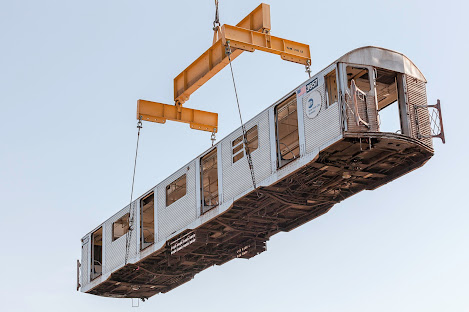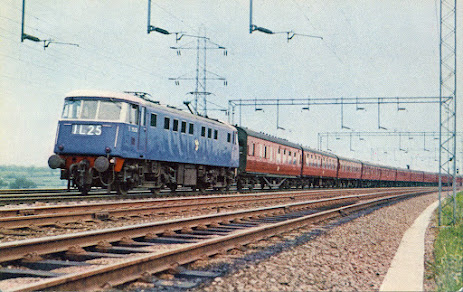Thursday, September 30, 2021
narrow gauge military steam train, Poland, interwar years
Converted automobile bodies for the upper ranks, more basic for the lower ranks from the look of it.
No other details.
peasant versus train race, Yugoslavia, circa 1937
The caption says that after mocking the oldest railway in the country, an employee challenged the peasant, named Yoyin Milovich, to run faster than the train between Bar and Sutorman. Milovich accepted. And Milovich won.
That loco looks a fairly old one so maybe the outcome is believable. Published in the French magazine Le Pelerin. The area is today in Montenegro.
Wednesday, September 29, 2021
Tuesday, September 28, 2021
Monday, September 27, 2021
Sunday, September 26, 2021
Saturday, September 25, 2021
SNCF 40100 class at Bruxelles Midi with TEE train 'L'Oiseau Bleu' in 1979
It was a class of 10 units built in 1964 (first batch of 4), and 1969–1970.
(40104-10) 4,480 kW (6,010 hp)
Nevada Northern museum railway 2-8-0 now restored and running
Friday, September 24, 2021
Southern Electric, England, multiple unit art
A Southern Electric train on a Portsmouth to London Waterloo service shown approaching Farncombe Station in 1960. A fabulous artwork by Philip D. Hawkins.
Wednesday, September 22, 2021
South Australian Railways cape gauge 2-6-0 from 1876
A total 8 of these U class were built by Beyer, Peacock and Company and were the first to work the SAR narrow gauge lines. Of these 4 were later rebuilt but none were preserved.
Tuesday, September 21, 2021
cape gauge ore train from Broken Hill arrives at Port Pirie, Australia, circa 1951
"Charles Rasp's discovery of silver ore at Broken Hill in 1883 eclipsed many smaller finds found in the region from 1875 and led to the formation of BHP. When the New South Wales government refused to build a railway to Broken Hill to bring supplies in and take the ore out, the South Australian government obliged: for a short time there were arguments over which port should be used, but by a narrow vote in Parliament, the die was cast for Port Pirie. The railway line to the New South Wales border was laid by June 1887; this connected with the private Silverton Tramway Company. With the railway line open everything for and from Broken Hill went through Port Pirie -- timber for the mines, coal and mining gear and outwards the ore and processed minerals. Smelters were built at Port Pirie and the face of the town changed rapidly -- it became an industrial town as well as a port.
"In 1889 11,000 tons of coke was sent in six months from Port Pirie to Broken Hill; 4 million superfeet of timber was handled; 11,244 tons of silver-lead bullion was despatched and BHP (Broken Hill Proprietary Ltd) paid £69,000 for railway cartage and labour."
Monday, September 20, 2021
Sunday, September 19, 2021
Flying with the KLM from Amsterdam to Paris in 1929, colorized
"Fly with the KLM with a Fokker F.VII aircraft from Amsterdam to Paris in 1929. No long check-in times, no conveyer belts, no gates, no luggage claim areas, no queues, no removal of belts and shoes, no jumbo's, but instead just a simple step ladder to board the plane with your suitcase in your hand to join the other half-a-dozen passengers. Aircraft in those times were noisy, cold, choppy and could only fly at low altitude because of the lack of a pressure cabin. Seats were made of wicker and the only entertainment was the stewardess trying to serve coffee while attempting to keep her balance..."
South Australian Railways 750 class 2-8-2
They were all ex-VR N class. This example, 752, is now preserved. Info here
Saturday, September 18, 2021
NYC's old Subway cars at the bottom of the Ocean
"There is nothing more satisfying than seeing the city's subway cars—stages of so many sigh-inducing commutes and a variety of other horrors—getting unceremoniously dumped into the vast, blue ocean. It's a place where they are free from manspreaders and the MTA—a place where they transform into something a little more useful, it turns out.
"As we know, once these old retired subway cars hit the ocean floor (all 18-tons of them), they begin their new life as artificial subway reefs, creating "a flourishing new habitat for varied sea life including sea bass, tuna, mackerel, flounder, blue mussels, sponges, barnacle, and coral, and improved marine environments in areas of the ocean floor that were once barren deserts." Think Barnacle Bike, but bigger.
"The subway reef program ran from August 2001 through April 2010, when the MTA "deployed more than 2,500 deaccessioned train cars to underwater locations off the coasts of New Jersey, Delaware, Maryland, Virginia, South Carolina, and Georgia." This included the carbon steel "Redbird" cars, and stainless steel "B-Division/Brightliner" cars, which were all refurbished into "cleaned shells " before being thrown overboard. This means they were stripped of motors, wheels, hydraulics, lighting, Freon from the air conditioning systems, seats, and windows."
Euston to Carlisle Express hauled by an 81 class locomotive circa 1961
the Melbourne to Adelaide 'Overland' train seen in the Adelaide Hills
A postcard with no date - 1970s? A pair of South Australian 930 class diesels provide the power, although they look to be in the same as the NSW livery of the time. They were normally seen in a red and silver scheme, as were the cars, see below.
Thursday, September 16, 2021
'SS Catalina' passenger ship
Seen in 1955 in Avalon Bay on Catalina Island. Also known as The Great White Steamer, this was a 1,766 grt, 301-foot (94-metre) steamship built in 1924 that provided passenger service on the 26-mile passage between Los Angeles and Santa Catalina Island from 1924 to 1975. According to the Steamship Historical Society of America, Catalina has carried more passengers than any other vessel anywhere. From August 25, 1942 until April 22, 1946 the ship served as the Army troop ferry U.S. Army FS-99 at the San Francisco Port of Embarkation transporting more than 800,000 troops and other military personnel between embarkation camps and the departure piers. After a period of service as a floating discothèque, the ship ran aground on a sandbar in Ensenada Harbor in 1997 and partially sank on the spot. It was scrapped in 2009.
Wednesday, September 15, 2021
1934 Duesenberg SJ Torpedo Convertible Victoria
"by Rollston. This Supercharged 8-cylinder, 320-horsepower legend was one of the most powerful motorcars in the world (at that time), capable of a top speed approaching 140 mph [225 km/h]"
Tuesday, September 14, 2021
model of a one-car English Electric unit used in the Wellington area
Monday, September 13, 2021
Sunday, September 12, 2021
Saturday, September 11, 2021
steam train on the 215 metre long Červený most (Rothe Bridge), Bratislava
Early 20th century in the era of the Austro-Hungarian Empire, hence the German and Hungarian names.
A recent aerial view is here
Friday, September 10, 2021
Western Australian Government Railways Ec class 4-6-2
A total of 20 Ec class engines were built by Baldwin Locomotive Works, Philadelphia, in the first half of 1901, and entered service with the WAGR later that year. The following year, Baldwin built the first of two batches of the C class, a lighter version of the Ec class.
Initially, the Ec class' main task was to haul heavy trains on the Eastern Goldfields Railway. Between 1920 and 1923, nine Ec class engines were lightened for use on the lightly laid Northam to Mullewa line, and reclassified as the Eca class.
All 20 were withdrawn between 1923 and 1925, with the frames, wheels, cabs and tenders married with new boilers, cylinders and valve gear at Midland Railway Workshops to become the L class. The costs of the rebuilds were recovered within four years through lower maintenance costs.

















































